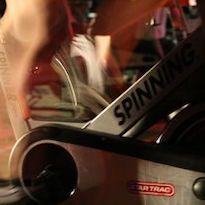You’ve heard me talk about improving efficiency by helping students improve their technique. But did you know that doing so might decrease caloric burn? Yup, you heard me right. But wait! Don’t go deciding not to help students improve their form because you’re afraid they’ll mutiny if they knew about that calorie thing. There’s more to it…Let Joe Friel educate you on this topic. Joe Friel has written another excellent blog post that applies to anyone teaching indoor cycling, especially if you are working with your students to improve economy and efficiency (i.e. things like pedaling better, relaxing the upper body and not bouncing in the saddle). Click here to read Part 1 of Joe’s post on economy. While you’re there, sign up for his free newsletter so you won’t miss Part 2 (I’ll post part 2 on the Sage Advice blog).
In my periodized cycling clinics at the moment we are working on efficiency of the pedal stroke to improve economy. When you are more economical, you utilize less O2 to accomplish the same task. The often withheld secret to this though is that utilizing less O2 translates to burning fewer calories for a given effort.
What?? Fewer calories? Noooooooo, my students don’t want to hear that – if I do that they will mutiny and walk out of class if I talk about efficiency!
Now wait a minute, we’re not done! I do think it’s important that you as a coach should know on a physiological level what being “economical” means. Just like in your own personal budget, being economical means paying less for something, and in this case, the currency is calories. But, you’ve got to explain to them that you don’t want the effort that they expend to be lost in the “ether” – we would rather that their effort go into something productive that does them some good such as increase resistance (and ultimately power). The human body is only about 20-25% efficient – and some of the lost effort cannot be improved (heat, genetics, etc), but that which can improved – such as your technique – can really help you improve your ability to pedal for longer periods without fatiguing as easily. When you improve your economy, it means you are not wasting those calories on non-productive activities like tensing muscles, bouncing, or pedaling in a jerky motion, etc. Instead, you should be able to channel that “wasted” energy into increasing power output at that heart rate. That means doing more for the same effort. Using our financial analogy, that means paying the same for something but getting more for it – like maybe free shipping! ;-). In other words, it means more value. Indoors, that will translate to greater overall caloric burn as power output increases, and for cyclists outside, it translates to increased speed for the same effort.
So by all means – help your students improve their economy through technique drills. But if your students are super focused on calories (you know, the kind that compares their “calories burned” on their HRM after every class and tells you that they “burn” more calories in Billy-Bob’s class), you might want to leave the information about burning fewer calories out of it because that is all they will hear. They may tune out the additional information you give them. Instead, skip over that part and tell them that as their technique improves they will ultimately burn more calories.
It takes awhile, becoming more economical doesn’t happen overnight. But it is something that we all should be working on every time we ride.
Coming soon at ICA – pedal stroke drills and other ways to improve economy. I will also post an article on how to pedal faster at a lower heart rate (i.e. more efficiently). It’s what I’m currently working on with my own pedaling, and probably my biggest personal challenge.
Note: Copyright ICA, all rights reserved. However, you have the permission of ICA to email this link or reproduce it in another medium as you see fit. If you reproduce it on a blog or flyer, make sure to not only include the link to Joe Friel’s blog post, but also include the link to the Indoor Cycling Association.

